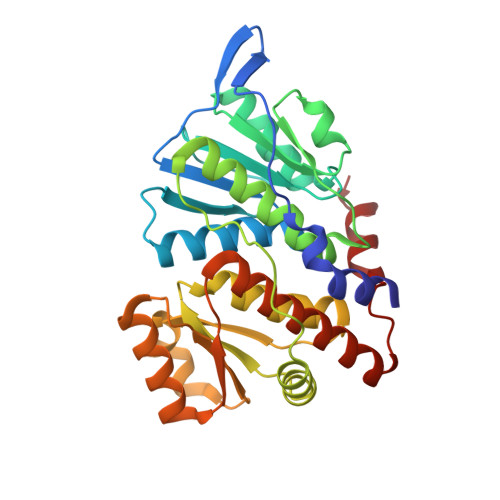A novel phosphoglucose/phosphomannose isomease from the crenarchaeon Pyrobaculum aerophilum is a member of the PGI superfamily: structural evidence at 1.16 A resolution
Swan, M.K., Hansen, T., Schoenheit, P., Davies, C.(2004) J Biological Chem 279: 39838-39845
- PubMed: 15252053
- DOI: https://doi.org/10.1074/jbc.M406855200
- Primary Citation of Related Structures:
1TZB, 1TZC - PubMed Abstract:
The crystal structure of a dual specificity phosphoglucose isomerase (PGI)/phosphomannose isomerase from Pyrobaculum aerophilum (PaPGI/PMI) has been determined in native form at 1.16-A resolution and in complex with the enzyme inhibitor 5-phosphoarabinonate at 1.45-A resolution. The similarity of its fold, with the inner core structure of PGIs from eubacterial and eukaryotic sources, confirms this enzyme as a member of the PGI superfamily. The almost total conservation of amino acids in the active site, including the glutamate base catalyst, shows that PaPGI/PMI uses the same catalytic mechanisms for both ring opening and isomerization for the interconversion of glucose 6-phosphate (Glc-6-P) to fructose 6-phosphate (Fru-6-P). The lack of structural differences between native and inhibitor-bound enzymes suggests this activity occurs without any of the conformational changes that are the hallmark of the well characterized PGI family. The lack of a suitable second base in the active site of PaPGI/PMI argues against a PMI mechanism involving a trans-enediol intermediate. Instead, PMI activity may be the result of additional space in the active site imparted by a threonine, in place of a glutamine in other PGI enzymes, which could permit rotation of the C-2-C-3 bond of mannose 6-phosphate.
- Department of Biochemistry and Molecular Biology, Medical University of South Carolina, Charleston, South Carolina 29425, USA.
Organizational Affiliation:


















